
The common moorhen, also known as the waterhen or swamp chicken, is a bird species in the rail family (Rallidae). It is distributed across many parts of the Old World.

The water rail is a bird of the rail family which breeds in well-vegetated wetlands across Europe, Asia and North Africa. Northern and eastern populations are migratory, but this species is a permanent resident in the warmer parts of its breeding range. The adult is 23–28 cm (9–11 in) long, and, like other rails, has a body that is flattened laterally, allowing it easier passage through the reed beds it inhabits. It has mainly brown upperparts and blue-grey underparts, black barring on the flanks, long toes, a short tail and a long reddish bill. Immature birds are generally similar in appearance to the adults, but the blue-grey in the plumage is replaced by buff. The downy chicks are black, as with all rails. The former subspecies R. indicus, has distinctive markings and a call that is very different from the pig-like squeal of the western races, and is now usually split as a separate species, the brown-cheeked rail.

The clapper rail is a member of the rail family, Rallidae. The taxonomy for this species is confusing and still being determined. It is a large brown rail that is resident in wetlands along the Atlantic coasts of the eastern United States, eastern Mexico and some Caribbean islands. This species was formerly considered to be conspecific with the mangrove rail.

The yellow-browed bulbul, or golden-browed bulbul, is a species of songbird in the bulbul family, Pycnonotidae. It is found in the forests of southern India and Sri Lanka. The yellow-browed bulbul is mainly yellow on the underside and olive above with a distinct yellow brow. They are easily located by their loud calls but tend to skulk within foliage below the forest canopy. While its taxonomic classification has changed over time, it is currently the sole species within the monotypic genus Acritillas which is closely related to Hemixos.

The green peafowl or Indonesian peafowl is a peafowl species native to the tropical forests of Southeast Asia and Indochina. It is the national bird of Myanmar. Formerly common throughout Southeast Asia, only a few isolated populations survive within Cambodia and adjacent areas of Vietnam. It has been listed as endangered on the IUCN Red List since 2009, primarily due to widespread deforestation, agriculture and loss of suitable habitat, severely fragmenting the species' populations and contributing to an overall decline in numbers. Due to their natural beauty, they are still sometimes targeted by the pet trade, feather collectors, and even by hunters for meat. They are a much-desired bird for private and home aviculturists, despite their rather high-maintenance care requirements.

The black rail is a mouse-sized member of the rail family Rallidae that occurs in both North and South America.

The white-bellied woodpecker or great black woodpecker is a woodpecker species inhabiting evergreen forests in tropical Indian subcontinent and Southeast Asia. It is among the largest of the Asiatic woodpeckers and nests in large dead trees, often beside rivers. It has 14 subspecies, and many of its island forms are endangered, some are extinct. Populations differ in the distribution and extent of white. Its drums and calls are louder than those of the smaller woodpeckers.

Ridgway's rail is a near-threatened species of bird. It is found principally along the Pacific Coast of North America from the San Francisco Bay Area to southern Baja California, as well as in some regions of the Gulf of California. A member of the rail family, Rallidae, it is a chicken-sized bird that rarely flies. Its common name and Latin binomial commemorate American ornithologist Robert Ridgway.

The jungle nightjar is a species of nightjar found in the Indian Subcontinent. It is found mainly on the edge of forests where it is seen or heard at dusk. The taxonomy of this and related nightjars is complex and a range of treatments have been followed that cover this and several other nightjars in the Asian region. It was formerly called the grey nightjar or Indian jungle nightjar and sometimes included the East Asian grey nightjar as a subspecies.
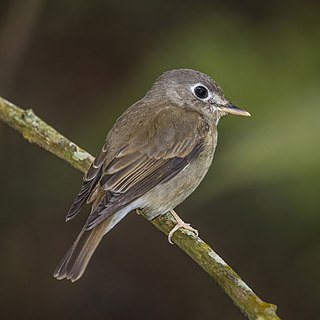
The brown-breasted flycatcher or Layard's flycatcher is a small passerine bird in the flycatcher family Muscicapidae. The species breeds in north eastern India, central and Southern China and northern Burma and Thailand, and migrates to southern India and Sri Lanka. It forages for insects below the forest canopy, often close to the forest floor.

Rallus is a genus of wetland birds of the rail family. Sometimes, the genera Lewinia and Gallirallus are included in it. Six of the species are found in the Americas, and the three species found in Eurasia, Africa and Madagascar are very closely related to each other, suggesting they are descended from a single invasion of a New World ancestor.

The African rail is a small wetland bird of the rail family that is found in eastern and southern Africa.

The sand lark is a small passerine bird in the lark family, Alaudidae, found in southern Asia. It is somewhat similar to, but smaller than the short-toed larks.
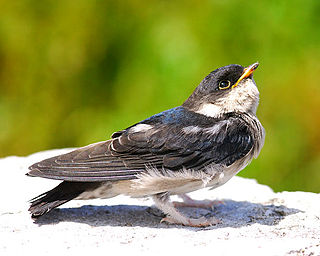
The Asian house martin is a migratory passerine bird of the swallow family Hirundinidae. It has mainly blue-black upperparts, other than its white rump, and has pale grey underparts. Its three subspecies breed in the Himalayas and in central and eastern Asia, and spend the winter lower in the mountains or in Southeast Asia. This species is locally abundant and is expanding northward in Siberia, so there are no concerns about its conservation status.

The snow pigeon is a species of bird in the genus Columba in the family Columbidae from hilly regions of central Asia. They are grey, black, pale brown and white birds and two subspecies are recognised: C. l. leuconota occurs in the western Himalayas from western Afghanistan to Sikkim and C. l. gradaria occurs in the mountains of eastern Tibet and from eastern Nan Shan (Qinghai) to Yunnan and extreme northern Myanmar. The birds forage in open country in pairs or small groups, feeding on grain, buds, shoots, berries and seeds. They roost at night on cliffs, breeding in crevices where they build untidy stick nests and lay a clutch of usually two white eggs. The International Union for Conservation of Nature has rated the bird's conservation status as being of least concern.

The Bogotá rail is a Vulnerable species of bird in subfamily Rallinae of family Rallidae, the rails, gallinules, and coots. It is endemic to Colombia. The bird is a typical medium-sized rail with a plump body that is laterally compressed, a short tail and an elongated bill.

The blue whistling thrush is a bird in the Old World flycatchers family Muscicapidae that is found in the mountains of Central Asia, South Asia, China and Southeast Asia. It is known for its loud human-like whistling song at dawn and dusk. The widely distributed populations show variations in size and plumage with several of them considered as subspecies. Like others in the genus, they feed on the ground, often along streams and in damp places foraging for snails, crabs, fruits and insects.
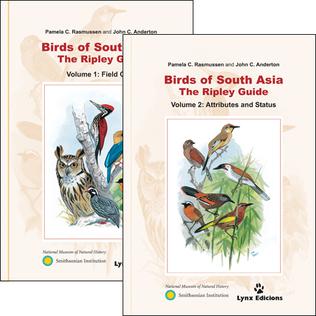
Birds of South Asia: The Ripley Guide by Pamela C. Rasmussen and John C. Anderton is a two-volume ornithological handbook, covering the birds of South Asia, published in 2005 by the Smithsonian Institution and Lynx Edicions. The geographical scope of the book covers India, Bangladesh, Pakistan, Sri Lanka, Nepal, Bhutan, Maldives, the Chagos Archipelago and Afghanistan. In total, 1508 species are covered. Two notable aspects of Birds of South Asia are its distribution evidence-base — the book's authors based their distributional information almost completely on museum specimens — and its taxonomic approach, involving a large number of species-level splits.
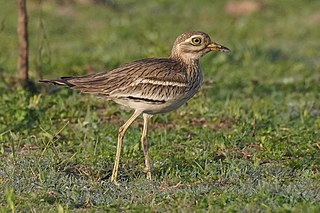
The Indian stone-curlew or Indian thick-knee is a species of bird in the family Burhinidae. It was formerly included as a subspecies of the Eurasian stone-curlew. This species is found in the plains of South and South-eastern Asia. They have large eyes and are brown with streaks and pale marks making it hard to spot against the background of soils and rocks. Mostly active in the dark, they produce calls similar to the true curlews, giving them their names.
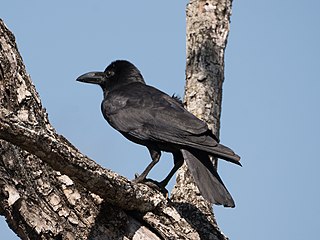
The Indian jungle crow is a species of crow found across the Indian Subcontinent south of the Himalayas. It is very common and readily distinguished from the house crow, which has a grey neck. In the past the species was treated as a subspecies of another crow species, but vocalizations and evidence from ectoparasite co-evolution and phylogenetic evidence have led to it being considered as a distinct species in modern taxonomic treatments. It differs in its voice from the large-billed crow found in the higher elevations of the Himalayas and the eastern jungle crow overlaps in the eastern part of its range. In appearance, it can be difficult to distinguish from either of these species although the plumage tends to be more uniformly glossed in purple and has a longer bill with a fine tip and a less arched culmen. The Himalayan species has a slightly wedge-shaped tail, unlike the rounded tail of the Indian jungle crow and tends to glide a lot.























